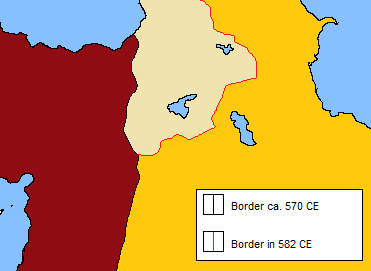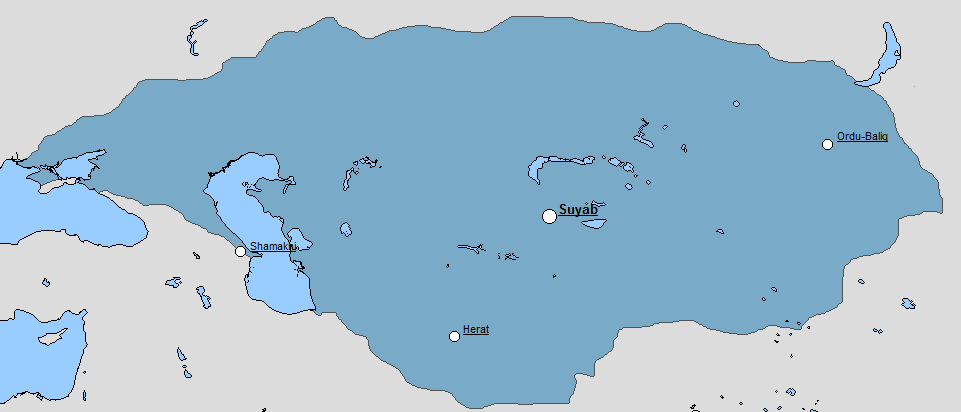Roman-Sassanid War of 577 - 582 CE
The perennial fate of the Roman and Sassanid Empires was, it seems, to fight one another. The next round had been delayed by Persia's fumbling around with the Aksumites in Yemen, but within half a decade, the conflict was almost inevitable. Pro-Roman revolts wracked the Christian portions of the Persian Caucasus, and Khosrau was determined to make an example of the rebellious Christians to save face after the Yemeni debacle. Once the crackdowns on the revolts began in earnest, the Romans declared war in support of their brothers in the faith, and crossed the border with the intention of marching on Dvin and liberating the whole of Persian Armenia. Khosrau, who had successfully baited the Romans into open conflict, executed the first Iranian victory of the war at Bolum late in 577, forcing the Romans back over the frontier. There the Roman army wintered in Theodosiopolis, which Khosrau placed under siege.
By the coming of spring, however, Justinian, the magister militum of the East, arrived with a cadre of fresh troops, raising the siege and driving the Iranians back over the border. From here, it appears, the tides turned, as the Iranian siege of Dara in Mesopotamia was thwarted in 579 by the armies of al-Mundhir ibn al-Harith [1] of the Ghassanids, and the Romans and their Armenian confederates advanced in the Caucasus. Khosrau died some time in the same year, and was succeeded by his son, Hormizd. As the Sassanids' military fortunes seemed to grow worse by the day, Hormizd, vengeful for the reverses his Empire had experienced at the hands of the Christians in his father's reign, seems to have vented his frustrations upon his own Christian subjects, the Nestorians of Persia. Long accused of Roman sympathies, the Christians of the Sassanid Empire had last been persecuted four decades before during Khosrau's reign. Despite this, the Church of Persia had striven to prove its loyalty in moving farther theologically from Roman orthodoxy.
With the arrest of the Patriarch Ezekiel, however, the Christians could tolerate no more. Across Mesopotamia and Persia open revolt flared, suppressed brutally by Hormizd. When the king's son, Khosrau, was struck dead by a Christian assassin, the vengeful king had Ezekiel executed. Distraught, the Christians of the Sassanid Empire went into hiding, their leaders fleeing abroad, largely to the Roman Empire and to Transoxiana.
As the civil strife in Persia continued, the Romans advanced in Armenia, capturing Dvin late in 581 and crushing the army of the general Adarmahan a few months afterwards. The campaign wound down to a halt when news came that the Emperor Justin had died, and that his caesar, Tiberius Constantine, had taken the throne. The new Emperor sent peace feelers to the court in Ctesiphon, where Hormizd, still overcome with rage at the death of his son, refuses. It is only when the magnates of Persia, sick of Hormizd's draconian rule and military blunders, deposed and blinded the king that the truce could come to realization.
The peace was a punishing one for the Iranians, but not one that they could contest with their armies in the condition they were - all of Armenia and Iberia would pass under Roman ownership, and the two Empires would renew their 50-year treaty of peace. The new king Bistam, brother of Hormizd, signed the peace reluctantly, wishing to end the war and to restore order in his new Empire.
The consequences of this brief but brutal war were of monumental importance. The expansion of Roman rule in the Caucasus and northern Mesopotamia would tax the Empire, which had already strengthened its control of Italy and, to an extent, the province of Spania (although the consequences of this victory on the Romans would not be seen for almost three decades). More immediately, Persia's defeat had made it weak in terms of military and prestige in the eyes of its neighbors, and its Christian populace, despite the end of the fierce prosecution, were embittered.
To the north and the southwest, vultures circled...
The state of the Roman-Iranian frontier, before and after the War of 577 - 582.
--------------------------------------------------------
[1] - Who was not implicated of treason by Maurice and deposed, as he had been IOTL.
--------------------------------------------------------
I guess I lied about there being no territorial changes.

